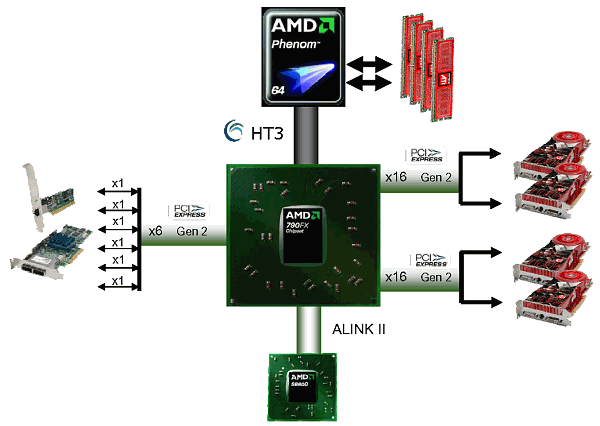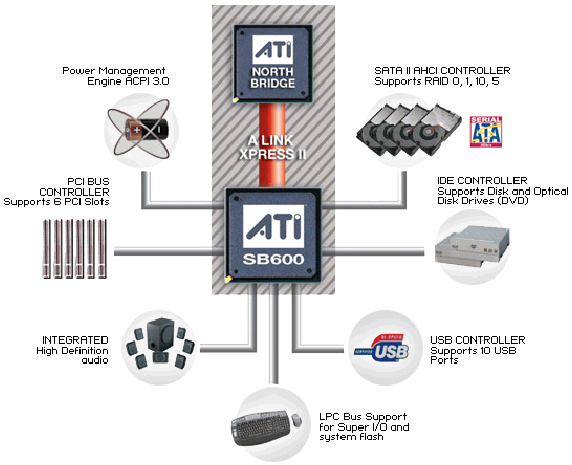 |
||
|
||
| ||
While a processor can be compared with brains, a chipset can definitely be regarded as the heart of a platform, because functionality of motherboards and computers in general depends on this very component. As Phenom processors are positioned as a gaming solution in the first place, AMD decided to launch a chipset family with similar positioning to support these processors. Having bought ATI, AMD managed to accomplish this task without resorting to the help of third-party companies. Perhaps, AMD wouldn't have minded stressing the open nature of its platform and reporting about a similar chipset from NVIDIA, but NVIDIA failed to implement PCI Express 2.0 in its chipset by this date. NVIDIA is only planning to launch a chipset with PCI Express 2.0 support based on an external bridge (the chipset will preserve a built-in PCIE 1.0 controller), which does not look like a good idea, to tell the truth. It will be available for the Intel platform (this chipset wouldn't have made sense for AMD, because of the chipsets to be reviewed in this article). However, the sterling support for PCI Express 2.0 from NVIDIA with extended SLI configurations is also round the corner - such chipsets for both platforms must appear in the beginning of 2008.  There are three chipsets in this family, which differ only in the number of graphics ports (and PCI Express lanes) and consequently in supported CrossFire modes. All these chipsets support Hyper-Transport 3.0 to connect with Phenom processors, preserving compatibility with Hyper-Transport 1.0 (in previous processors for Socket AM2). Maximum bus clock rate has grown from 1000 MHz to 2600 MHz. Thus, its throughput has grown from 6.4 GB/s to 20.8 GB/s. But as existing Phenom processors are designed for 1800-2000 MHz, maximum throughput is up to 14.4-16.0 GB/s. PCI Express 2.0 bus also possesses twice as high throughput as its previous version, 8 GB/s versus 16 GB/s for PCI Express x16 and 0.5 GB/s versus 1 GB/s for PCI Express x1. Backward compatibility is preserved. Each port can be automatically configured for an expansion card of the old standard, while the others may operate with maximum throughput.  The most functional version of the north bridge, which is shown above, supports 42 PCI Express 2.0 lanes, 32 of which are intended for graphics ports, another 6 lanes can be used for integrated controllers and PCIE expansion ports, and 4 lanes are used to connect to the south bridge. In this case configurations include:
Thus, the chipset caters for requirements of even the most hardcore gamers, support for more graphics cards will hardly be necessary in the forseeable future. The same concerns the number of PCI Express lanes. Note that the throughput of PCI Express 2.0 x8 equals that of PCI Express 1.0 x16. So there shouldn't be bottlenecks even if you install a lot of graphics cards, especially if we take into account that the cards interact via the external bridges, and PCIE links within the north bridge are connected via XpressRoute. We have plans to analyze all SLI modes in the nearest future.  This flow chart shows a PCI Express controller. Its 32 lanes are divided into two blocks, a separate engine is dedicated to each 8 PCI Express lanes. So, when four cards are installed, all four engines work to support their respective graphics cards. Two engines are grouped for two cards to get 16 lanes in each graphics slot. In both cases the blocks are connected with the above-mentioned XpressRoute bus to exchange data between the graphics cards. The 790X chipset is possibly based on the same die as the 790FX. The graphics ports operate as x16+x8, when two cards work independently. In CrossFire mode, the ports are forced to operate as x8+x8 (we'll check it out, because specifications of various motherboards differ here). There is only one CrossFire mode - a couple of graphics cards are paired to work together. However, AMD offers the most attractive graphics cards in the Mid-End segment. Considering the reduced heat release of the Radeon HD 3800 cards, such configurations finally look practical. The AMD 770 recipe is obvious, engineers just removed the second block from the 790FX. So only one graphics port is supported. It's hard to say whether this block is physically present in the chip or removed. But it makes no practical difference to users, as unlocking has been out of the question for a long time already, even if units are locked on the logical level. Interestingly, it will be the first chipset with a single graphics slot for AMD/ATI after a long period. ATI used to offer chipsets supporting CrossFire only.  Even the 790FX chip is surprisingly small. We've never seen such small north bridges in chipsets before. That's the consequence of the 65 nm fabrication process. We should add a few words here.  It's no secret that up to now chipsets have been manufactured on old production facilities, because state-of-the-art lines are in short supply. So it makes sense for CPU companies to use them for processors. However, support for high-clocked buses requires units operating at frequencies similar to CPU speed. Hence, a thin fabrication process won't hurt a chipset. First of all, it will help reduce heat release, make cooling systems cheaper, raise reliability, and enhance the overclocking potential. As AMD uses TSMC services to manufacture chipsets and graphics processors, the company probably didn't have to sacrifice CPU production facilities. Interestingly, the old platform approach from AMD suggested to compare prices of not just processors, but of mobo-CPU combos. Now this approach also suggests to take into account the total power consumption. It's quite correct and easy to realize, because tests very often measure power consumption of a motherboard with a processor. Power consumption of an entire system is measured even more often.  Along with new CrossFire modes and system buses in this chipset family, AMD offers a significant addon to BIOS. It will interest overclockers (who want to do it without much effort). As we have already found out with our Gigabyte MA790FX-DQ6, OverDrive utility works very well. It offers much more options, especially for memory timings, than the BIOS can offer. As it's a unified module, it will be much easier for motherboard manufacturers to provide overclocking features and test their motherboards from the point of view of overclockers. Consumers will always get a tool for overclocking.  The chipset uses SB600 as its south bridge, but there are plans to upgrade it to SB700. It's too early to speak about its characteristics (it will include RAID 5 mode and probably more interfaces). But since ATI chipsets caught up with their competitors in reliability and performance with USB devices, there have been no objective reasons for complains. Manufacturers of expensive motherboards will still equip their products with additional controllers as they please. SB600 specifications:
ConclusionsThe new family of chipsets from AMD looks very good owing to its support for Phenom processors. Even though motherboards for Socket AM2 on the existing chipsets are still popular with the appearance of processors for Socket AM2+ due to their cross compatibility, AMD has chosen the right time to update its line of chipsets, inherited from ATI. Support for Hyper-Transport 3.0 and PCI Express 2.0 is necessary, because these standards are ready. But it wouldn't have made sense until the appearance of processors and graphics cards supporting these standards. Support for configurations with many graphics cards and positioning of the platform (AMD Phenom + AMD 790FX, in the first place) for gamers is not accidental either. Firstly, CrossFire modes with more than two cards may reveal the practical effect of system buses with the impressively increased bandwidth. Secondly, this positioning looks more important and strategically correct for the processor. In the current situation with the new-born DirectX 10, performance in modern games with high quality settings depends solely on a graphics card. But in time (as DX10 graphics cards evolve), the stress may again shift to CPU capacities, so Phenom with its 128-bit SSE will be able to reveal its full potential. Dmitry Laptev (lpt@ixbt.com)
February 7, 2008 Write a comment below. No registration needed!
|
Platform · Video · Multimedia · Mobile · Other || About us & Privacy policy · Twitter · Facebook Copyright © Byrds Research & Publishing, Ltd., 1997–2011. All rights reserved. |